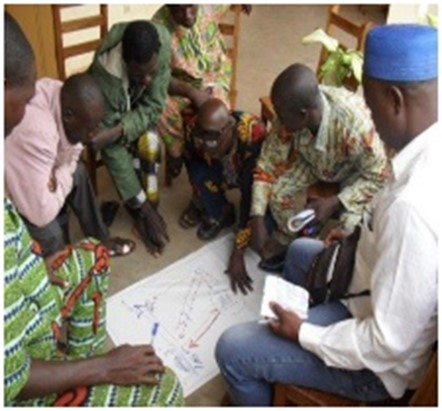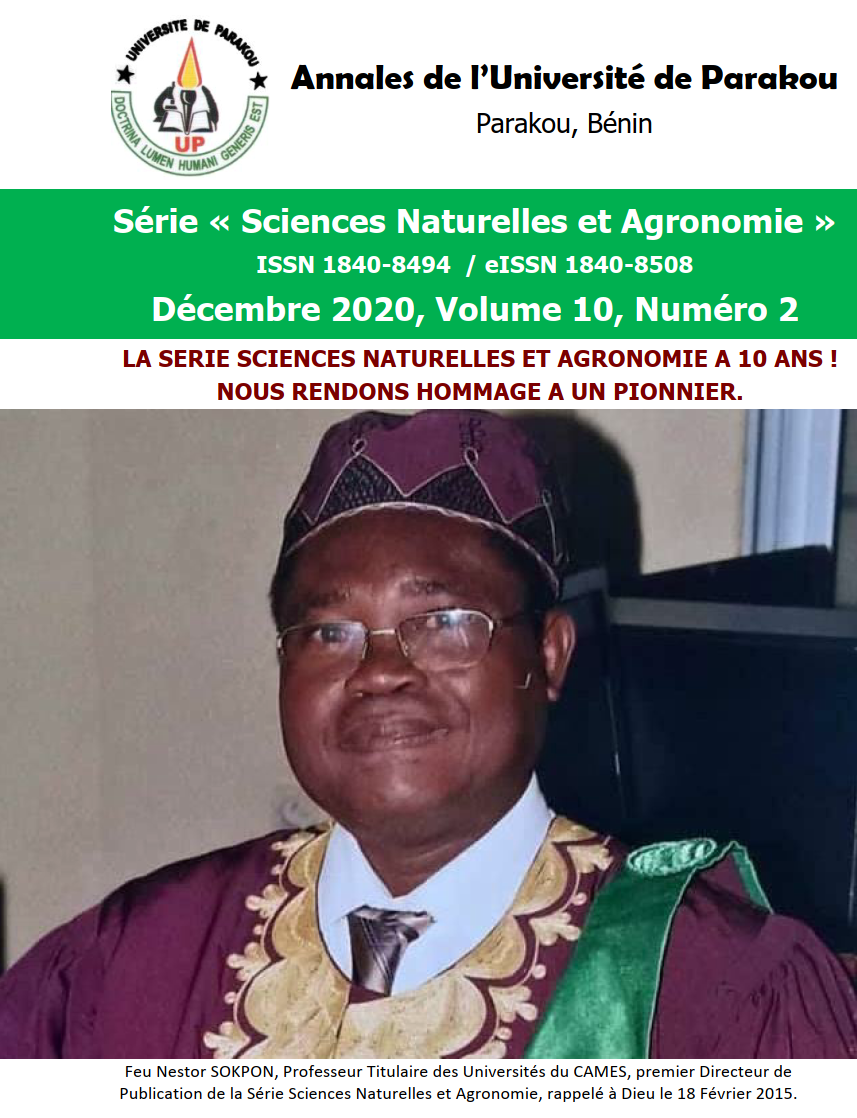Efficacité de l’utilisation des Animateurs Relais dans la mise en œuvre du conseil à l’exploitation familiale au Bénin
DOI :
https://doi.org/10.56109/aup-sna.v12i1.108Mots-clés :
Efficacité, Animateurs Relais, Conseil à l’exploitation familiale, BéninRésumé
Le principal défi de la vulgarisation et du conseil agricole au 21ème siècle est de mettre au point des approches durables de conseil qui placent des paysans au centre comme des agents de changement au sein de leur communauté. La vulgarisation de paysan à paysan (VPP) est l’une de ces approches qui a connu une croissance en Afrique cette dernière décennie. L’étude a évalué l’efficacité de l’utilisation des Animateurs Relais (AR) dans la mise en œuvre du conseil à l’exploitation familiale (CEF) par le Programme d’appui aux dynamiques productives. Les données ont été collectées auprès d’un échantillon aléatoire de 226 producteurs. Nos résultats ont montré que les adhérents ont connu une amélioration significative des capacités de gestion de trésorerie (87%), de stock de production (89%), de la main d’œuvre (70%), de planification de leurs activités (85%) et dans la définition d’un projet de développement de leur exploitation (95%). Aussi, les résultats ont-ils montré une réduction des contraintes techniques des principales cultures (68%), suivie d’une augmentation des rendements (76%). Enfin, une augmentation des revenus (91%) et une amélioration de la sécurité alimentaire (73%) ont en outre été constatées. Le profil socioéconimque des AR, l’effet de groupe, associés à la mise en œuvre du CEF expliquent les résultats obtenus.
Téléchargements
Références
Amudavi D.M., Khan Z.R., Wanyama J.M. Midega C.A.O. Pittchar J. Nyangau I.M. et al. 2009. Assessment of technical efficiency of farmer teachers in the uptake and dissemination of push–pull technology in Western Kenya. Crop Prot. 28: 987–996. DOI: https://doi.org/10.1016/j.cropro.2009.04.010
Birkhaeuser D., Evenson R.E. & Feder G. 1991. The economic impact of agricultural extension: A review. Econ. Dev. Cult. Change 39: 607–650. DOI: https://doi.org/10.1086/451893
Birner R., Davis K., Pender J., Nkonya E., Anandajayasekeram P., Ekboir J. et al. 2009. From best practice to best fit: a framework for designing and analyzing pluralistic agricultural advisory services worldwide. J. Agric. Educ. Ext. 15: 341–355. DOI: https://doi.org/10.1080/13892240903309595
Braun A.R. & Hocdé H. 2000. Farmer participatory research in Latin America: Four cases. Working with farmers: the key to adoption of forage technologies. Proceedings of an international workshop held in Cagayan de Oro City, Mindanao, Philippines: 32- 53
Bunyatta D.K., Mureithi J.G., Onyango C.A. & Ngesa F.U. 2006a. Farmer field school effectiveness for soil and crop management technologies in Kenya. J. Int. Agric. Ext. Educ. 13: 47–63.
Bunyatta D.K., Mureithi J.G., Onyango C.A. & Ngesa F.U. 2006b. Farmer field school effectiveness for soil and crop management technologies in Kenya. J. Int. Agric. Ext. Educ. 13: 47–63. DOI: https://doi.org/10.5191/jiaee.2006.13304
Cameron D. & Chamala S.A. 2004. Measuring impacts of an holistic farm business management training program. Aust. J. Exp. Agric. 44: 531–538. DOI: https://doi.org/10.1071/EA02058
David S. 2007. Learning to think for ourselves: Knowledge improvement and social benefits among farmer field school participants in Cameroon. J. Int. Agric. Ext. Educ 14: 35–50. DOI: https://doi.org/10.5191/jiaee.2007.14203
Davis K., Nkonya E., Ayalew D. & Kato E. 2009. Assessing the impact of a farmer field schools project in East Africa: 24–28. In: 25th Annual Conference of the Association for International Agricultural and Extension Education (AIAEE), San Juan, Puerto Rico.
de Romémont A. 2014. Apprentissage et réflexion stratégique des producteurs agricoles: construction de la proactivité dans le conseil à l’exploitation familiale au Bénin.Thèse de doctorat, Université Sup Agro, Montpellier, France, 534 p.
Dinpanah G., Mirdamadi M., Badragheh A., Sinaki J.M. & Aboeye F. 2010. Analysis of Effect of Farmer Field School Approach on Adoption of Biological Control on Rice Producer’Producer’Characteristics in Iran. Agric Env. Sci 7: 247–254.
Dolly D. 2009. An assessment of the implementation and outcomes of recent farmer field schools to improve vegetable production in Trinidad and Tobago. J. Int. Agric. Ext. Educ. 16: 7–19. DOI: https://doi.org/10.5191/jiaee.2009.16201
Dugué P. & Faure G. 2001. Le conseil aux exploitations familiales: 13-19. In: Dugué P. Faure G. & Boval V. (eds). Actes de l’atelier sur le conseil aux exploitations agricoles en Afrique de l’Ouest et du Centre. GRET-CIRAD, France
Dube L. 2017. Farmer to farmer extension approach: Analysis of extent of adoption by smallholder farmers in Manicaland and Masvingo provinces of Zimbabwe. J. Agric. Econ. Rural Dev. 3 : 149–160.
Endalew B.D. 2009. Effectiveness of Farmer Field School Promoting Coffee Management Practices: The Case of Jimma and Sidama Zones. Master Thesis, Haramaya University, 157p.
Evenson R. 1997. The economic contributions of agricultural extension to agricultural and rural development. In: Burton E. S. Robert P. B. & Andrew J. S. (eds). Improving Agricultural Extension. A Reference Manual. FAO. Rome.
Faure G., Beauval V. & Dugué P. 2004. Conseil à l’exploitation familiale: expériences en Afrique de l’Ouest et du Centre. GERT-CIRAD, France.
Faure G., Davis K.E., Ragasa C., Franzel S. & Babu S.C. 2016. Framework to Assess Performance and Impact of Pluralistic Agricultural Extension Systems. The Best-fit Framework Revisited. IFPRI-CIRAD, Washington, USA.
Faure G., Pautrizel L., De Romemont A., Toillier A., Odru M. & Havard M. 2015. Note 8: Management advice for family farms to strengthen entrepreneurial skills. GFRAS Good Pract. Note Ext. Advis. Serv. GFRAS, Lindau Switz.
Feder G. & Savastano S. 2006. The Role of Opinion Leaders in the Diffusion of New Knowledge: The Case of Integrated Pest Management. World Dev. 34: 1287–1300. DOI: https://doi.org/10.1016/j.worlddev.2005.12.004
Franzel S., Sinja J. & Simpson B. 2014. Farmer-to-farmer extension in Kenya: the perspectives of organizations using the approach. World Agrofor. Cent. Work. Nairobi, Kenya. DOI: https://doi.org/10.5716/WP14380.PDF
Hellin J. & Dixon J. 2008. Operationalising participatory research and farmer-to-farmer extension: the Kamayoq in Peru. Dev. Pract. 18: 627–632. DOI: https://doi.org/10.1080/09614520802181889
Hellin J., Rodriguez D., Coello J. & Hellin J. 2002. Measuring the livelihood impact of farmer-to-farmer extension services in the Andes. Intermed. Technol. Dev. Group Bourton Hall Bourton--Dunsmore Warwicks. CV23 9QZ.
Hofisi F. 2003. Farmer field schools as a learning process for resource-poor farmers. Master Thesis, Swedish University of Agricultural Sciences, Department of Rural Development Studies, Uppsala, 47p.
Igué A.M., Oussou B. & Adoko F. 2016. Fertilité des sols au Bénin. Résultats de l’étude de fertlité des sols ménées dans 4 départements au Bénin (Rapport de recherche). ProSOL, Giz, INRAB, MAEP, Bénin.
Karuhanga M., Kiptot E., Kugonza J., Wabwire R. &Franzel S. 2012. The effectiveness of the volunteer farmer-trainer approach in feed technology dissemination in the East Africa Dairy Development Project in Uganda. World Agroforesty Cent, Nairobi, Kenya.
Kassem H.S. 2014. Effectiveness of different agricultural extension methods in providing knowledge and skills in disease prevention: A case of Smallholder Poultry Production Systems in Dakhalia Governorate of Egypt. Asian J Agr Ext Eco Sociol 3 (2) : 91 107. DOI: https://doi.org/10.9734/AJAEES/2014/7010
Kaufman R. & Keller J. M. 1994. Levels of evaluation: Beyond Kirkpatrick. HRD Quarterly. 5: 371-380. DOI: https://doi.org/10.1002/hrdq.3920050408
Kiptot E. & Franzel S. 2015. Farmer-to-farmer extension: opportunities for enhancing performance of volunteer farmer trainers in Kenya. Dev. Pract. 25: 503–517. DOI: https://doi.org/10.1080/09614524.2015.1029438
Kiptot E. & Franzel S. 2012. Effectiveness of the farmer trainer approach in dissemination of livestock feed technologies: A survey of volunteer farmer trainers in Kenya. World Agroforesty Cent, Nairobi, Kenya.
Kiptot E., Franzel S., Hebinck P. & Richards P. 2006. Sharing seed and knowledge: farmer to farmer dissemination of agroforestry technologies in western Kenya. Agrofor. Syst. 68: 167–179. DOI: https://doi.org/10.1007/s10457-006-9007-8
Kiptot E., Karuhanga M., Franzel S. & Nzigamasabo P.B. 2016. Volunteer farmer-trainer motivations in East Africa: practical implications for enhancing farmer-to-farmer extension. Int. J. Agric. Sustain. 14: 339–356. DOI: https://doi.org/10.1080/14735903.2015.1137685
Kundhlande G., Franzel S., Simpson B. & Gausi E. 2014. Farmer-to-farmer extension approach in Malawi: A survey of organizations. ICRAF, Nairobi, Kenya. DOI: https://doi.org/10.5716/WP14384.PDF
Lukuyu B., Place F., Franzel S. & Kiptot E. 2012. Disseminating improved practices: Are volunteer farmer trainers effective? J. Agric. Educ. Ext. 18: 525–540. DOI: https://doi.org/10.1080/1389224X.2012.707066
Machacha A. 2008. Farmer field schools in Bungoma district of western Kenya: a rapid appraisal. Master Thesis, Iowa State University, 107 p.
Mancini F., Van Bruggen A.H. & Jiggins J.L. 2007. Evaluating cotton integrated pest management (IPM) farmer field school outcomes using the sustainable livelihoods approach in India. Exp. Agric. 43: 97–112. DOI: https://doi.org/10.1017/S001447970600425X
McLean S. & Moss G. 2003. They’re happy, but did they make a difference? Applying Kirkpatrick’s framework to the evaluation of a national leadership program. Can. J. Program Eval. 18 (1).
Mulwafu A.O. & Krishnankutty J. 2012. Prospects of lead farmer concept for improved livestock development among rural communities in Malawi. Indian Res. J. Ext. Educ. I : 121–127.
Mwambi M., Kiptot E. & Franzel S. 2015. Assessing the effectiveness of the volunteer farmer trainer approach in dissemination of livestock feed technologies in Kenya vis-à-vis other information sources. ICRAF, Nairobi, Kenya. DOI: https://doi.org/10.5716/WP15022.PDF
Noordin Q., Niang A., Jama B. & Nyasimi M. 2001. Scaling up adoption and impact of agroforestry technologies: experiences from western Kenya. Dev. Pract. 11: 509–523. DOI: https://doi.org/10.1080/09614520120066783
Padyp P. 2014. Rapport trimestriel d’activités, Juillet-Septembre 2014 du Programme d’Appui aux Dynamiques Productives (PADYP) (Rapport d’activités No. 25 ème trimestre Padyp). SOFRECO, AFD, MAEP, Cotonou, Bénin.
Praneetvatakul S. & Waibel H. 2006. Impact assessment of farmer field school using a multi period panel data model. The Conference of the International Association of Agricultural Economists, Citeseer, Gold Coast.
Ramdianee M.M. 2013. Motivation of volunteers in not-for-profit organisations supporting children with life-threatening illnesses in Western Australia. PhD Thesis, Curtin University, Austrilia, 182 p.
Rustam R. 2010. Effect of integrated pest management farmer field school (IPMFFS) on farmers knowledge, farmers groups ability, process of adoption and diffusion of IPM in Jember district. J. Agric. Ext. Rural Dev. 2: 029–035.
Scarborough V., Killough S., Johnson D.A. & Farrington. J. 1997. Farmer-led extension : Concept and practices. Intermediate Technology Publications Ltd. London, United Kingdom. DOI: https://doi.org/10.3362/9781780444949.000
Selener D., Chenier J. & Zelaya R. (1997). Farmer-to-farmer extension: lessons from the field. The International Institute of Rural Reconstruction (IIRR), Quito, Ecuador
Simpson B.M., Franzel S., Degrande A., Kundhlande G. & Tsafack S. 2015. Farmer-to-farmer extension: Issues in planning and implementation. Mod. Ext. Advis. Serv.
Simpson B.M. & Owens M. 2002. Farmer field schools and the future of agricultural extension in Africa. J. Int. Agric. Ext. Educ. 9: 29–36. DOI: https://doi.org/10.5191/jiaee.2002.09204
Simpson D. 1997. Tee impotence of participation: an examination of the integrated pest management-farmer field school program in svay teap, Cambodia. Master Thesis, Carleton University, Ottawa, 201p.
Ssemakula E. & Mutimba J.K. 2011. Effectiveness of the farmer-to-farmer extension model in increasing technology uptake in Masaka and Tororo Districts of Uganda. South Afr. J. Agric. Ext. 39: 30–46.
Tsafack S., Degrande A., Franzel S. & Simpson B. 2014. Farmer-to-farmer extension in Cameroon: a survey of extension organizations. World Agrofor. Nairobi, Kenya. DOI: https://doi.org/10.5716/WP14383.PDF
Van den Berg H. 2004. IPM Farmer Field Schools: A synthesis of 25 impact evaluations. Wageningen University, Netherlands.

Téléchargements
Publiée
Comment citer
Numéro
Rubrique
Catégories
Licence
(c) Tous droits réservés Philippe TCHEGNON, Ismail M. MOUMOUNI, Mohamed N. BACO, Jacob A. YABI, Simplice D. VODOUHE 2022

Ce travail est disponible sous la licence Creative Commons Attribution 4.0 International .












